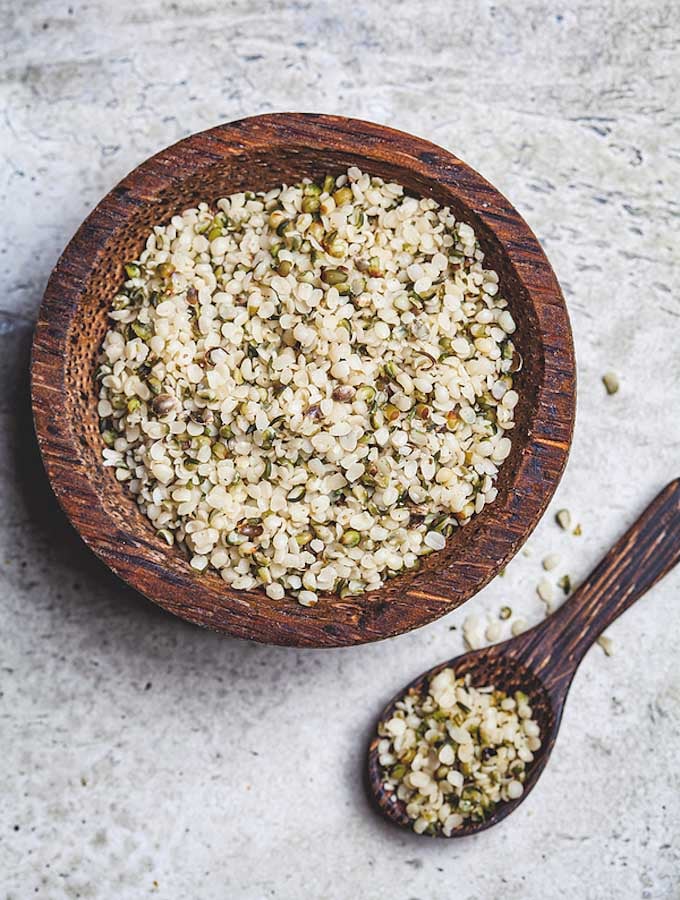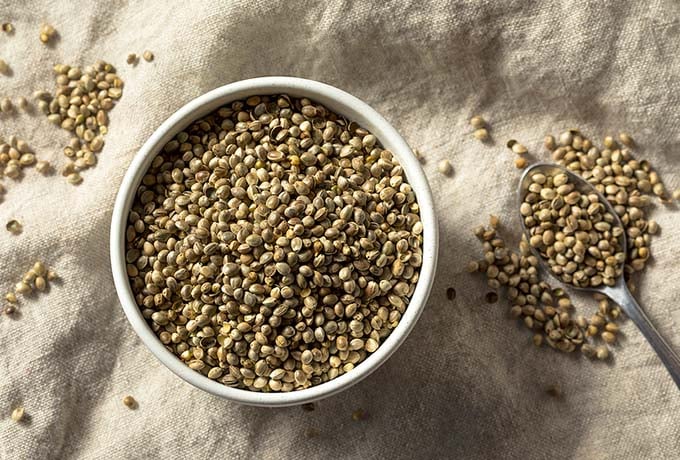Subtly crunchy, mild in flavor, yet boldly rich in nutrients, hemp seeds have a whole lot to offer wholesome food fans across the ages. This guide to hemp seeds has tips on buying and storing, simple ideas, and links to lots of recipes for using this versatile superfood.

These tiny yet mighty seeds are so versatile — they can be simply sprinkled on soups, salads, smoothie bowls, used in cookies, bars, and energy balls, and turned into a delicious plant-based milk.
What is Hemp and Where Did It Come From?
Historic records show that it was cultivated in China as far back as 8000 BCE as fiber for rope, clothing, and pottery. The oil also had medicinal uses, very similar to many modern applications.
Throughout a couple of thousand years, this once wild grass was domesticated across all continents. By the year 1533, King Henry VIII of England would fine farmers that weren’t growing hemp. It was such an important crop that no one could slack on production. In 1620, when pilgrims landed at Plymouth Rock, these founding mothers and fathers lit their new households using hemp oil as fuel.
Rising again in popularity as a superfood, hemp seeds are enjoying renewed attention for their culinary capabilities. Canada had been a major exporter of hemp seeds and other hemp products throughout the 1990s, but it was a legal grey area about their salability in the US.
Hemp and marijuana have very different meanings in the eyes of the law, but they’re simply two different names for the same plant. Simply put, hemp used for food won’t get you high.
It remained a contentious subject right up until January 1, 2020, when the FDA finally announced that hulled hemp seed, hemp seed protein powder, and hemp seed oil were generally regarded as safe (GRAS) for human consumption.
 Hemp seeds before being hulled
Hemp seeds before being hulled
How to Buy and Store Hemp Seeds
Hulled hemp seeds or “hemp hearts” are the standard way that hemp seeds are sold. The whole seed is protected by a very tough outer shell, which makes it harder to digest, and not as tasty, so it’s typically removed when sold as food. Of course, you could always sprout whole hemp seeds for a highly nutritious microgreen, but you’ll likely need to seek those out online.
Most health food stores or high-end grocery stores like Whole Foods will have at least two or three hemp seed brands to choose from. Some of the top brands are Manitoba Harvest, Nutiva, and Navitas. Expect to pay between $8 to $10 for about 8 ounces.
Like other seeds and nuts, hemp seeds contain volatile oils that will go rancid over time. That’s why it’s best to buy hemp seeds that are vacuum-sealed in pouches, not from bulk bins. Check expiration dates to make sure that they’re fresh. After opening, keep them that way by refrigerating. Stashing them in the freezer for long-term storage, where they’ll last for at least one year, if not more.
How to Toast Hemp Seeds
Hemp seeds can be used raw, right out of the package, or lightly toasted. Applying heat amplifies their inherently nutty, subtly buttery taste. To do so, you can toast them in a dry skillet over medium-low heat for 5 to 8 minutes, until golden brown and aromatic, stirring often. Let cool completely before using.

Hemp Seed Nutrition Notes
Hemp seeds pack an incredible amount of good fats, protein, vitamins, and minerals into such a tiny package. They are exceptionally rich in omega-6 and omega-3 fatty acids, which can otherwise be challenging to get on a plant-based diet.
In fact, this whole food is better than many synthetic supplements, as it’s also a great source of vitamin E, phosphorus, potassium, sodium, magnesium, sulfur, calcium, iron, and zinc.
Hemp seeds are a great source of plant-based protein 11 grams of protein per 3-tablespoon serving, according to WebMD, where you’ll find complete nutrition data. Moreover, hemp seeds are a complete protein source, which means they provide all 9 essential amino acids. That’s why they’re such a popular ingredient in many protein bars, powders, and shakes. Here
As little as 1 to 2 tablespoons, a typical serving size, will allow you to reap some of this tiny seed’s multitude of benefits.

Hemp Serving Suggestions
Cream and milk substitutes: Just add water and you’ll have a creamy beverage that’s perfect for drinking, pouring over cereal, baking, and beyond. Use a high-powered blender and strain thoroughly for the best, smoothest results. Here are easy recipes for 2-Ingredient Hemp Milk and Hemp Milk Creamer.
Meaty ground alternative: Adding texture and protein, hemp seeds can help bolster a blend of chopped vegetables, such as mushrooms and eggplant, to mimic the look and texture of beefy ground. You can even bind them with ground flaxseeds to make plant-based meatloaf or meatballs.
Grain bowls: Sprinkle a tablespoon or two over the top of your next buddha bowl, served hot or cold, for an extra nutritional boost.
Salads: Toss hemp seeds in with your leafy greens or save them for an eye-catching finishing touch. In some cases, you can use hemp seeds to partially replace whole grains in grain-based salads. They’re especially good tabbouleh salads, in which they complement tiny grains like bulgur, quinoa, or couscous.
Soups: Especially useful for making creamy, dairy-free bisques, hemp seeds are an excellent choice for blending into a warm, savory soup. Tomato soup, potato soup, mushroom soup, and beyond; anything that calls for a bit more richness will do well with hemp seeds in the mix.
Hot cereal: Warm up with a bowl of oatmeal topped with hemp seeds for a more satisfying, toothsome texture.
Cookies and bars: Make a wholesome protein bar using ground hemp seeds or turn simple cookies into a better-for-you treat. Whole hemp seeds work particularly well in oatmeal or sesame cookies since they have similar textures and tastes.
Smoothies and smoothie bowls: Blend hemp seeds into a creamy drink that’s secretly full of superfoods or top off a smoothie bowl with even more toast hemp seeds to double down on nutrition.

Vegan Recipes Using Hemp Seeds
Energy snacks
- Pumpkin Seed & Hemp Seed Brittle
- Cranberry-Pecan Granola
- Cocoa-Date Energy Balls
- Easy Peanut Butter Chocolate Truffles
Beverages and smoothies
Cookies & bars
Plant-based meatballs & burgers
Sauces and dips
Salads
Explore more of this site’s Good Food Guides.
Contributed by Hannah Kaminsky: Hannah has developed an international following for her delicious recipes and mouthwatering food photography at the award-winning blog BitterSweet. Passionate about big flavors and simple techniques, she’s the author of Vegan Desserts, Vegan à la Mode, Easy as Vegan Pie, Real Food, Really Fast, Sweet Vegan Treats, The Student Vegan Cookbook, Super Vegan Scoops, and The Everyday Vegan Cheat Sheet Pan. Visit Hannah at BittersweetBlog.com.
All photos: Bigstock

Leave a Reply